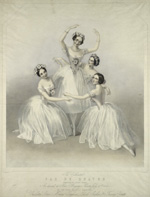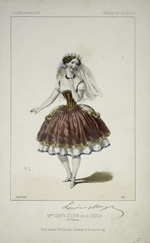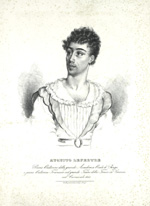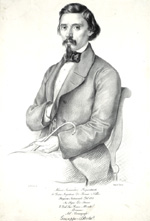Romanticism: Ballerinas and Danseurs
Pas
de Quatre

Pas de Quatre
Lithograph
by T. H. Maguire from a drawing by A. E. Chalon, [London, 1845].One of the most celebrated Romantic ballet
images, this lithograph commemorated the divertissement choreographed by Jules
Perrot at Her Majesty's Theatre, London,
in 1845.The dance was a quartet--hence
its title,
Pas de Quatre--for luminaries of the Romantic ballet, and
with the exception of the Danish ballerina Lucille Grahn (second from right),
all were Italian.Dominating the image
is Marie Taglioni, standing with her arms
en couronne, with Grahn, Fanny
Cerrito, and Carlotta Grisi paying homage around her.With its delicate coloring, finish, and charm,
this splendid print exemplifies the iconography of the Romantic ballet.Cia
Fornaroli Collection.Jerome Robbins Dance Division.
A Fanny Elssler nell'ultima sera delle sue danze in Rome (To Fanny
Elssler on the last evening of her dances in Rome), 1846. To the delight of
Roman audiences, the Teatro di Apollo engaged both Fanny Elssler (in La
fanciulla di Gand [The Girl from Ghent]) and Marie Taglioni
(in La Silfide [La Sylphide]) for its 1845-1846 Carnival season. This
ode was one of many dedicated by Roman fans to the Austrian Elssler, "the
light Teutonic Sylphide," in the 1840s. Walter Toscanini Collection of
Research Materials in Dance, Jerome Robbins Dance Division.
Carlotta
Grisi in a pose from the "Pas de Diane" in La Jolie Fille de
Gand
(The Pretty Girl of Ghent)
Lithograph,
[Rome?], 1847.Born
in the Italianprovince of Istria annexed
by Austria in 1814, Carlotta
Grisi studied at La Scala and toured throughout Italy before
crossing the Alps to
pursue an international career.Engaged
by the Paris Opéra, Grisi created the title role of Giselle in 1841.A
great personal triumph, it was followed in 1842 by La Jolie Fille de Gand,
which contained a memorable solo for her as the huntress Diana.Grisi
did not return to Italy until
the Carnival season of 1846-1847, when she danced at the Teatro di Apollo in
Rome, a visit commemorated in this lithograph.The
most important season of the Italian theatrical calendar, the Carnival season
ran from Christmas through Lent.Jerome Robbins Dance Division.
Carlotta
Grisi in La Sylphide
Color
lithograph by Emilien Desmaisons from a drawing by Eugène Guérard, [Paris, 1844.]In addition to creating the starring roles
in Giselle (1841), La Péri (1843), Esmeralda (1844), and Paquita (1846),
Carlotta Grisi also danced in older works such as La Sylphide.Jerome Robbins Dance Division.
Fanny Cerrito
 Fanny Cerrito
Fanny Cerrito Lithograph
by L. G. from a drawing by E. Kulbach, [Rome,
184-?].Born and trained in Naples, Fanny Cerrito pursued
an international career, while remaining a presence on the Italian stage.She
danced the title roles in the La Scala premieres of
La Sylphide and
Giselle,
staged in 1841 and 1843, respectively, by the Italian choreographer Antonio
Cortesi.This print commemorates her frequent visits
to Rome in
the 1840s, when she performed the most famous ballets of her repertory.Cia Fornaroli Collection, Jerome Robbins Dance
Division.
Fanny
Cerrito in Alma, ou La Fille du Feu (Alma, or The Daughter of Fire)
Color
lithograph by Frédéric Sorrieu after the lithograph by Jules Bouvier, [Paris, 1842?].Set in medieval Germany and
exotic Moorish Spain, Alma was
about the statue of a beautiful young woman that came to life, then turned
back to stone when the heroine fell in love.The
ballet, choreographed by Jules Perrot in 1842, was restaged in Rome by André Deshayes,
Filippo Izzo, and Cerrito herself.Cia
Fornaroli Collection, Jerome Robbins Dance Division.

Auguste Lefebvre
Auguste
Lefebvre
Lithograph
by Giuseppe Deyé, [Venice,
1830].Auguste (or Augusto, as he is
called in this print) Lefebvre belonged to a dance dynasty that performed in
most of the major centers of eighteenth and nineteenth-century Europe.He danced
as a child with the Lefebre company in Seville,
continued his training in Paris, then pursued
a career in Italy,
where he partnered many of the era's leading ballerinas.This print commemorates his engagement as "first
French dancer" or
danseur noble at the Teatro La Fenice in Venice during
the Carnival season of 1829-1830.The
term "French" did not refer to Lefebvre's birthplace but rather to
the kind of roles he performed.The
primo
ballerino serio,
danzante,
di rango francese, or
primo
assoluto, whose name typically headed the cast list, performed pas de deux,
adagios, and dances in classical style.The
ballerino italiano or
di rango
italiano was a virtuoso dancer who performed roles demanding technical
brilliance.The realism of the portrait
is typical of many nineteenth-century Italian dance prints.Cia Fornaroli Collection, Jerome Robbins Dance
Division.
Egidio
Priora
Lithograph
by V. Battistelli from a drawing by Almerini, Rome, [1832].This
souvenir portrait, with its accompanying sonnet, memorialized Egidio Priora's
season at the Teatro di Apollo during the Carnival season of 1832.One
of Rome's most prestigious theatrical venues,
the Apollo rose to its position of eminence under the forty-year management
of the shrewd and resourceful impresario Vincenzo Jacovacci.Engaging the most glamorous stars of the day
and often placing them in competition with one another (as Dr. Louis Véron
did at the Paris Opéra), he transformed the Apollo into Rome's main house of ballet.Important seasons witnessed the production
of numerous lithographs and poems, which were often printed on silk, rolled
up, placed in bouquets, and tossed at the feet of the dancers during bows.After a successful career as a primo ballerino (or premier
danseur), Priora embarked on a career as a choreographer, often with his
daughter Olympia as ballerina.Jerome Robbins Dance Division.
Odoardo
Chiocchia
Color
lithograph by Ponthenier from a drawing by L. Martini, 1832.With his vivid expression and Napoleonic gesture,
Odoardo Chiocchia exemplifies a typical approach to the representation of the premier
danseur in Italy during the 1830s. Although the Romantic period in France witnessed
the precipitous decline of the male dancer, in Italy the dancing hero retained
the stature he had enjoyed in the previous century.Cia Fornaroli Collection, Jerome Robbins Dance
Division.

Giuseppe Rota
Giuseppe
Rota
Lithograph
by Danesi from a drawing by De Worsan, Rome, [1855].Born in Venice in 1822, Rota trained at the
Teatro La Fenice, where he performed for several seasons.He began to choreograph in his twenties, and
by the 1850s his works appeared regularly in major Italian theaters.Many of his ballets drew on literary sources--
Il
Conte di Montecristo (1856), on Alexandre Dumas' novel, and
Bianchi
e Negri (Whites and Blacks) (1853), on Harriet Beecher Stowe's
Uncle
Tom's Cabin.In the 1860s Rota embarked
on an international career, staging works at the Hofoper in Vienna, Her Majesty's
Theatre, and the Paris Opéra, where he created his last ballet,
La Maschera,
ou Les Nuits de Venise (The Mask, or Venetian Nights) a year before his
death in 1865.This lithograph commemorated
Rota's 1855 season at Rome's Teatro Argentina.Cia Fornaroli Collection, Jerome Robbins Dance
Division.